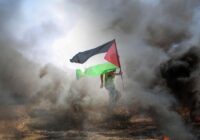It seems like we encounter a new terrorist group regularly these days, effectively forcing us to play a never-ending game of Wac-A-Mole. This constant battering keeps us in catch-up mode, attempting to put out fires when we should be preventing them in the first place.
To understand how terrorism begins, we must first understand radicalization. Radicalization is the process by which individuals or groups adopt an ideology that employs or supports violence, including acts of terrorism, to achieve a particular political or ideological goal. The concept of radicalization has evolved, but scientifically understanding and defining it remains a struggle.
Historically, researchers have biased research on radicalization. Early researchers focused on the correlation between radicalization and specific instances of terrorism or pervasive violence, highlighting the impact of detainment on individuals who, although not overtly violent, could potentially become radicalized during their incarceration.
In response to Islamist terror attacks in the early 2000s, like the 9/11 attacks in the United States and the 2004 Madrid train bombings in Spain, researchers turned to Muslim radicalization. Over time, several movements and ideologies took the spotlight. At one point, even the green movement was the case study for radicalization. Most recently, the literature has focused on the effects of the internet and social media.
At the heart of this constantly changing focus lies a conceptual confusion. Radicalization is not terrorism. It precedes terrorism and may not even necessarily lead to it. A new generation of researchers now looks at radicalization as a separate process, abstracting from violent outcomes, if any are even present, to focus on the psychology of radicalization. These researchers seek to explain how radical groups arise and why they receive sympathy from the broader public.
A case study of radicalization: Hamas
While various theories attempt to explain radicalization cohesively, the core issues remain the same. If you take everything from someone, there isn’t much left to lose. Depriving individuals of life’s essentials — food, water and shelter — and compounding their suffering with personal losses such as those of loved ones, homes and land, while simultaneously providing a specific entity to blame — be it the state, a racial group or a specified community — creates fertile ground for radicalization. Individuals may become swayed to believe that extremist actions are justified or feel compelled to participate in such activities in this environment of despair and attribution of blame. Extremist groups exploit this vulnerability to offer individuals grappling with despair a sense of purpose and belonging.
Consider the case of Hamas. Hamas is undeniably a terrorist group, yet one which enjoys significant support, at one point having 72% of Palestinians approving of them. This support cannot be solely attributed to antisemitism or hatred towards Israel; Palestinian Muslims have had a long history of peaceful life with both Jews and Christians. However, Palestinians and people worldwide cannot forget the last 80 or so years of pain.
Hamas’s October 7 attack on Israel and Israel’s subsequent bombardment and invasion of Gaza have created the perfect cocktail for them since. Let’s break it down. Famine has become unprecedentedly rampant in Gaza and death from dehydration is becoming a serious fear. Palestinians have lost loved ones, including premature babies. Palestinians have dealt with the Israeli government bombing homes and 690 educational institutions. Given the circumstances, it’s not surprising to see an increase in support and membership for Hamas – a voluntary group that employs direct violence against the Israeli government.
Israel’s invasion and even talk of settlement in Gaza have already backfired. Jerusalem is increasingly isolated diplomatically, and various bodies such as the UN, the International Court of Justice and the International Criminal Court have rebuked it and its leaders. Simultaneously, support for Palestine has risen among non-Palestinians, mainly Western youth. With direct access to the horrific conditions of Gazans through social media, more and more people are starting to sympathize with Hamas. They no longer see it as just a terrorist group. However, Hama is not the only example of radicalization, nor is the outcome of their efforts.
Truthfully, no matter how different the outcome, case and group, the radicalization process remains consistent. Juxtapose the case of Hamas with ISIS in Iraq. The invasion of Iraq stands as one of the greatest blunders in American foreign policy. This resulted in the devastation of the country in pursuit of nonexistent weapons of mass destruction. With the Iraqi government remaining weak and seeking assistance from the Kurds they once disdained, especially, given its once characterization by Arab nationalism. The aftermath of the Iraq war has left millions dead, homes destroyed and necessities in severe shortage.
Terror organizations often exploit conditions of isolation and discrimination, fueling hatred towards specific groups and motivating individuals to join their ranks. Islamic State (IS) utilized the loss experienced by Iraqis left with nothing to recruit more followers to their extremist ideology, gaining more followers since their founding in the 1990s.
Unlike previous groups, like al-Qaeda, IS had a global reach, specifically in recruitment, disseminating its anti-Western ideology through the internet and propaganda. Individuals susceptible to extremist beliefs based on their social, economic or political circumstances undergo a process of self-radicalization drawn by the allure of the group’s ideology. Thus, incidents like the San Bernardino attacks, where 14 people were killed and 21 injured and ISIS praised the shooters as supporters, were direct outcomes of IS’s radicalization efforts.
The perception of oppression can be just as potent as actual oppression, and it is not always based on the actual oppression. The clearest example is the January 6 attack on the United States Capital Building. Storming the Capitol required substantial support, with groups like the Proud Boys playing a significant role. Founded to polarize America, the Proud Boys employ violent rituals to train members. The attack, televised internationally, was made possible by the group’s reinforcement of violence within its ranks. The most significant talking point was taking the country back, insinuating the loss of land and country, and being very vocal about their loss of identity.
While their grievances may not be entirely valid, individuals deprived of support and privilege find solace in groups that provide a sense of belonging and assign blame to immigrants, women or liberalism. Isolation breeds susceptibility to self-radicalization, making marginalized individuals vulnerable to extremist ideologies propagated by groups like the Proud Boys.
Radicalization and its relation to terrorism
As noted above, radicalization doesn’t always lead to terrorism. Most of Hamas’s international sympathizers do not take direct action. Even women who supported IS and went so far as to travel to its territory and marry IS fighters were not violent; they were radicals, but not terrorists. Even government officials like Marjorie Taylor Greene can express radicalization, and this Republican congresswoman voiced support for the January 6 attack on the US Capitol.
Focusing on how we got here shows that each case is not unique and does not require handling differently, even though it may seem so. The magnitude of each group’s violence, or lack thereof, is not connected to their success in garnering support and membership. Still, it is relevant to their capabilities of forming a real movement. To effectively counter terrorism, we just need a comprehensive approach that emphasizes preventing the rise of future organizations, meaning heightened attention to both counter-radicalization and counterterrorism strategies.
For every action, there is an equal and opposite reaction, but in some cases, the reaction outweighs the original incident. Thus, we must consider every action we take to counteract terrorism of any kind because how many more terrorists are we creating in the process? Every counterterrorism operation should include an understanding of the consequences of the loss of life. Otherwise, on October 7 and January 6, Islamic State and al-Qaeda and even new cases will continue to develop as our past continues to haunt us.
Addressing radicalization requires an approach that goes beyond reactive counterterrorism measures. Let us take a comprehensive approach to counterterrorism that focuses on preventing future organizations’ success. We need to pay more attention to radicalization as well as counterterrorism tactics.
[Liam Roman edited this piece.]
The views expressed in this article are the author’s own and do not necessarily reflect Fair Observer’s editorial policy.
Support Fair Observer
We rely on your support for our independence, diversity and quality.
For more than 10 years, Fair Observer has been free, fair and independent. No billionaire owns us, no advertisers control us. We are a reader-supported nonprofit. Unlike many other publications, we keep our content free for readers regardless of where they live or whether they can afford to pay. We have no paywalls and no ads.
In the post-truth era of fake news, echo chambers and filter bubbles, we publish a plurality of perspectives from around the world. Anyone can publish with us, but everyone goes through a rigorous editorial process. So, you get fact-checked, well-reasoned content instead of noise.
We publish 2,500+ voices from 90+ countries. We also conduct education and training programs
on subjects ranging from digital media and journalism to writing and critical thinking. This
doesn’t come cheap. Servers, editors, trainers and web developers cost
money.
Please consider supporting us on a regular basis as a recurring donor or a
sustaining member.
Will you support FO’s journalism?
We rely on your support for our independence, diversity and quality.












Comment